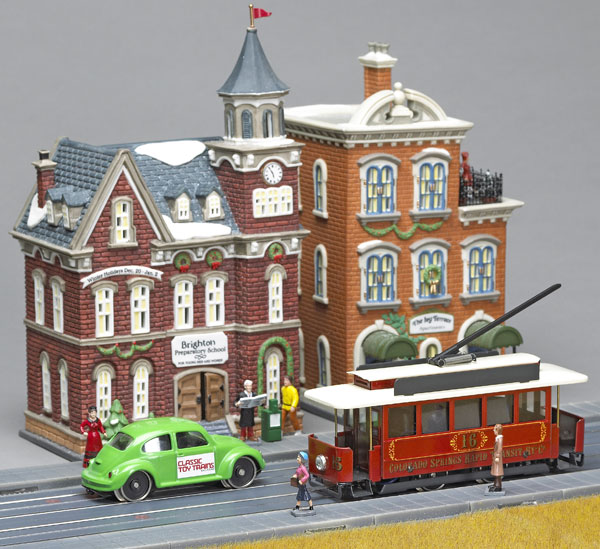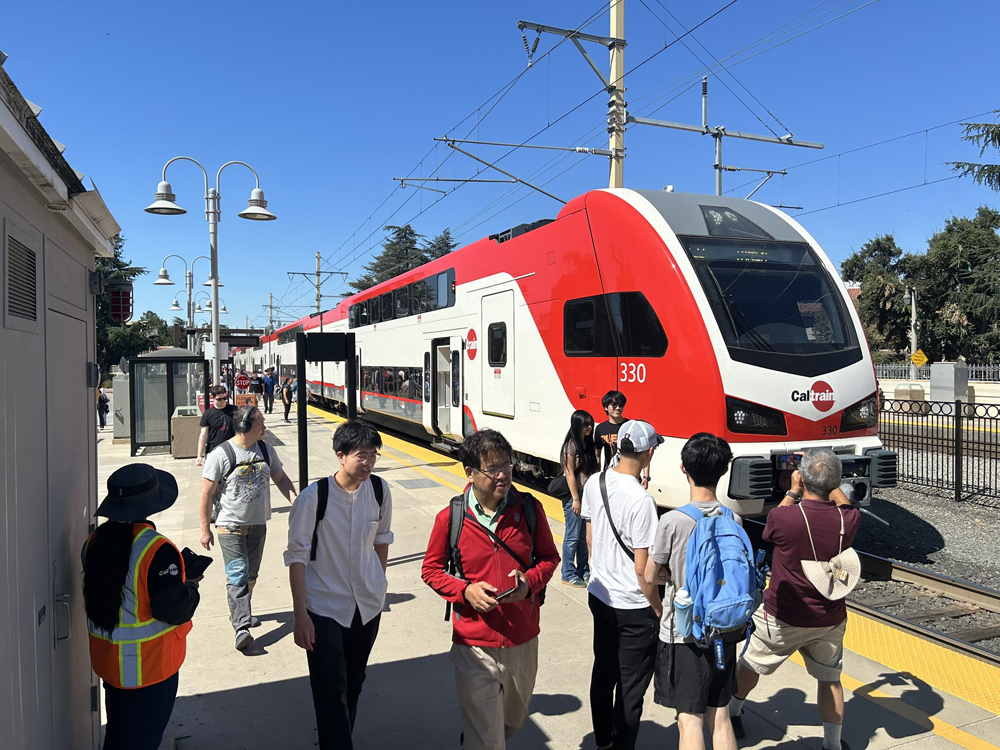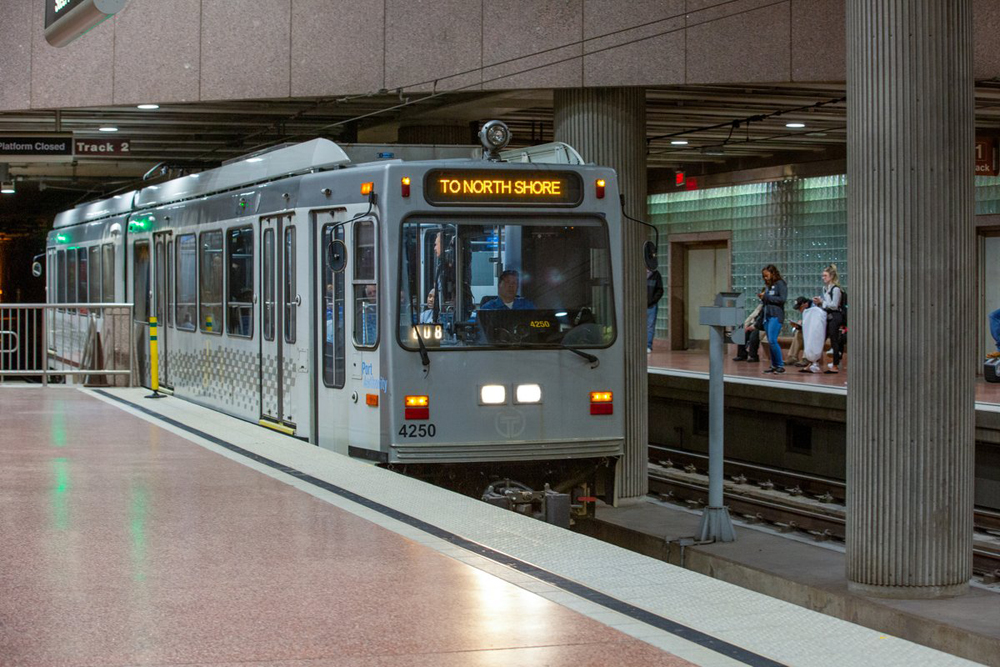We at CTT have been enraptured with the prospect of O gauge street running ever since we saw the two-rail cobblestone street system by Czech manufacturer ETS/SemafÖr (CTT, January, 2005). As attractive as that product is, it is two-rail only – three-railers are out of the loop. Until now.
K-Line delivers its own O gauge operating rail/street roadbed concept, complete with three-rail track. The SuperStreets line features two square-like tubular rails and a thin Super-O-esque center rail embedded in a gray plastic street surface.
Sections and connections
Let’s start with the basics.
The sample pack that we received from K-Line included enough street track for a small loop. In the box were nos. K-0812A 5-inch half-straight sections, K-0811A 4-inch straight-to-curve sections (these have wider grooves at one end to accommodate the arc of flanged wheels going through a curve), K-0802A D16 curves, and K-0813A 10-inch straight sections. We also received K-0849, a package containing two sets of hookup wire with special connectors.
The curves we tested are 16 inches in diameter; K-Line also offers 21-inch curves designed to nestle with the tighter curves to offer a “two-line” curve.
The raised roadbed is about 1/4 inch high, and 21/2 inches wide. The rails, mounted on the plastic base, are 1/16 inch high and are virtually flush with the roadbed. The underside is ribbed to accommodate the rails, but is otherwise open, like Lionel FasTrack and MTH Real Trax. But, as the photos show, SuperStreets looks like a section of highway with embedded rails, not a section of train track with ties and ballast.
Connecting the pieces is pretty straightforward. The base and the rails have alternate male/female connectors. The thin center rail has a narrow track plate (joiner) that slides into place to establish electrical connectivity.
The K-0811A 4-inch straight-to-curve transition section is worth special note. On straight sections of SuperStreets, the gap in the roadway to accommodate flanged wheels is relatively narrow. On curves, this gap opens up to keep the inside of wheel flanges from binding against the roadway as the wheels follow the arc of the curve.
The transition sections bring this gap down to size gradually. Without the transition, a trolley would ride up the plastic “pavement” and derail exiting a curve (look at the photo of this wide swing groove in the roadbed on page 89 and you’ll see what I mean).
Since regular O gauge track is “open” between the rails, this isn’t something most O gaugers would have previously encountered.
There were no instructions (or obvious connecting points) for mating the K-0849 wire set with streets. Flip over the track, though, and you’ll note some slightly thinner portions along the sidewall of the roadbed. We used wire cutters to trim a gap in the plastic and then set about mating the wires with the metal tabs, both of which run the width of the section to accommodate left-hand or right-hand connections.
SuperStreets is not a slot-car set, so there are no trigger-handle controllers connected to a dedicated transformer. Use whatever transformer you like to power the streets; or, for single-speed operation, even an accessory tap on an existing transformer will suffice.
Those brown circles on each section of SuperStreets are manhole covers. These hid pre-drilled holes for you to screw down SuperStreets sections and then cover the evidence – a great idea.
Connecting and disconnecting sections, as you would with a temporary Christmas layout, is fairly easy.
I’m not sure how well SuperStreets will hold up over years of connecting, disassembling, and reconnecting for a seasonal layout, so you may want to consider an arrangement to screw it down onto a lightweight wood base.
Streets on your layout
Before installing an operating street system on your layout, you should participate in one or two meetings of the Train Town Planning Board. Installation will probably be the largest urban renewal program since postwar Plasticville gave way to RailTown.
Sure, you can wing it “old school” by purchasing a box of SuperStreets and trying to make it fit. But you’ll be happier by using one or all of the three neat online resources that K-Line has created on its website, k-linetrains.com.
First up is a two-page roadway layout-planning guide that shows both current and planned street sections as well as ways to use single- or double-crossover sections to create busy intersections.
The second online feature is a three-page template package that you can print out. It features life-size track sections that you can clip out and use to give your street system a “dry run” before you go down to the hobby shop and make your big highway purchase.
Third is new SuperStreets software for the RR Trax brand of track-planning software. It’s available for free on K-Line’s website.
K-Line has cataloged a wide range of optional items to help with your urban planning. Some of the handy sections include the nos. K-0821 crossover, K-0822 double crossover, K-0823 wye track, K-0814 SuperStreets grade crossing, and K-0815 SuperStreets transition to O gauge section. Track pins and rail joiners are also available for separate sale.
As shown in photos in K-Line catalogs, SuperStreets enables you to run a two-lane avenue through town, allowing two-way traffic of K-Line motorized vans and delivery trucks.
If that’s not to your liking, you can use SuperStreets as a single-line trolley track running down the middle of a boulevard. If so, you’ll need to build up a street surface around the K-Line sections and add sidewalks, street lamps, and other curbside details for an effective scene. This challenge might be great fun, secondary only to creating your train layout in the first place! Peter Riddle’s story, “Simple City Scenery,” in the May 2005 issue contains some suggestions that will work well with Superstreets.
Vehicles and more
While I imagine that the line of K-Line vehicles will eventually grow, right now you’re pretty much limited to operating 1930s or 1980s delivery trucks that K-Line has cataloged, or existing railway equipment like trolley cars, track speeders, and some motorized units. Full-size locomotives can handle only the straight SuperStreets sections, because the curves are far too tight.
We didn’t have any K-Line vehicles available for our review, so we gathered a collection of tight-radius assets – trolleys, track speeders, and other motorized units – to see what would work and what wouldn’t. In the end, as a rule of thumb I’d use four-wheeled vehicles with a wheelbase no greater than that of an O gauge motorized handcar.
Here’s our unofficial tally of what worked and didn’t work on SuperStreets:
• Industrial Rail two-truck trolley: Nope. Wheelbase is too long; derailed on curves.
• Lionel rail bonder four-wheel motorized unit: Yep. Ran fine in all speed ranges.
• Marx four-wheel elevated subway train: So-so. The higher voltage, the better; flanges of powered unit occasionally hung up on curves.
• Marx four-wheel trolley: So-so. The higher voltage, the better; seemed to stall (light bulb went out) from lack of power connectivity.
• ETS/SemafÖr four-wheel trolley: Yep. Ran fine, though occasionally the tinplate coupler contacted the center rail.
• ETS/SemafÖr VW Beetle railcar (also sold by MTH): Yep. Superb runner at all speeds.
Postwar Lionel no. 41 switcher: Yep. Ran fine; occasionally spun wheels on curves, but did not stall.
Personally, I think you’d get the biggest bang for the buck using the K-Line system to incorporate a terrific right-of-way for trolleys, PCC cars, or even street-surface subway trains running down the middle of an avenue.
A slightly wider-radius curve would be needed for some of these motorized units, so it might be wise to design a street-to-tubular-track transition section for turnarounds on O-27 or O-31 track that is “out of sight” from observers.
Regardless of whether your SuperStreets hosts a trolley empire or a bustling internal-combustion boulevard, this is a clever item with the potential to change Train Town forever.














Items can be stored and travel in a suitcase each time I go to see grand kids. Simple and quick to assemble and take down. High curiosity and interest by "modern" cyber generation. KB
I did not have time to get the special hookup wire kit. I cut out the side adjacent to the connetion tabs & used slide connectors to get power to the street. I covered the protruding connectors with a plastic 'hump' from my kit junk box.